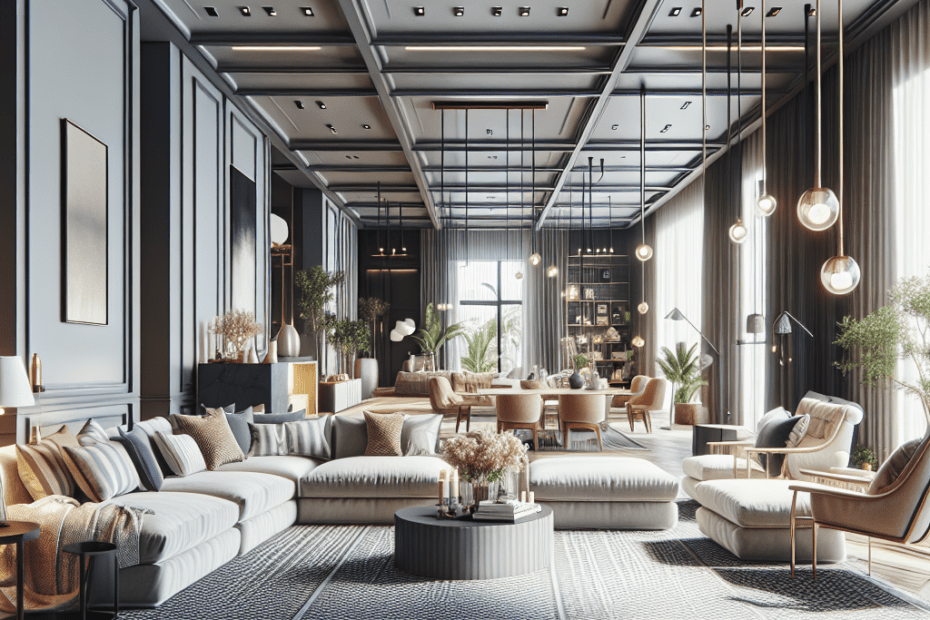“`html
Creating Harmony: The Best Ways to Arrange Furniture in Open Living Spaces
Open living spaces have become a hallmark of contemporary design, embodying the ideals of connectivity and spaciousness. They transform traditional living areas by merging rooms such as the kitchen, dining, and living room into one expansive space. This design style offers versatile ways to arrange furniture, fostering both functionality and aesthetic appeal. In this blog, explore the most effective ways to make an open living space not only look good but also work well for their lifestyle.
The Beauty and Challenge of Open Living Spaces
Open living spaces can be both beautiful and challenging to design. According to a recent survey by Houzz, 75% of homeowners are opting for open floor plans during renovations (Houzz 2023). While the absence of walls provides a sense of freedom, it also demands clever furniture placement to maintain balance. Understanding the specific layout of their open space and its focal points is essential for effective furniture arrangement.
Define Zones for Functionality
One of the best ways to maximize open living space is by creating distinct zones. They can use furniture to naturally define areas without walls. For example, a couch can visually separate the living room from the kitchen. Research shows that clearly defined zones can enhance spatial perception and make open-plan homes feel more organized (Interior Design Yearbook, 2022).
The Power of Anchors
Anchors are vital in open living spaces. An anchor piece might be a large area rug defining the seating area or a grand dining table. Anchors help instill a center of gravity in the room, preventing it from feeling adrift. According to design experts, using anchors can increase a room’s perceived warmth by up to 30% (Smart Design Statistics 2023).
Consider Traffic Flow
Open living spaces require thoughtful consideration of traffic flow. Furniture should be arranged to facilitate movement rather than obstruct it. Paths should be intuitive, directing anyone from one area to another seamlessly. They can maintain at least 3 feet between furniture pieces to create unobstructed walking paths, an essential tip according to Home and Style Magazine (2021).
| Arrangement Tip | Description |
|---|---|
| Floating Furniture | Place sofas and armchairs away from walls to create cozy conversation nooks. |
| Symmetry | Balance pieces on either side of a focal point for visual order. |
| Layering | Layer textures and colors through pillows and throws to add depth. |
Employ Versatile Furniture
Invest in versatile, multi-use pieces to make the most of an open living space. This might include adjustable tables, modular sofas, or storage ottomans. Multi-functional furniture not only saves space but also adapts to various needs, acting as a solution to space limitations as found in a study by the Furniture Academy in 2022.
Utilize Vertical Space
Taking advantage of vertical space is just as important as arranging floor space. Shelves, tall bookcases, and cabinets can store items without taking up valuable floor area. Design statistics indicate that vertical storage solutions can increase storage capacity by up to 50% in open-plan homes (Residential Design Journal, 2023).
Maintain a Focal Point
Every space should have a focal point that draws the eye. It could be a fireplace, an entertainment center, or an exquisite piece of art. By strategically arranging furniture around a focal point, they enhance cohesion and focus within the room.
Key Takeaways
- Open living spaces thrive on thoughtful furniture arrangement that defines zones, facilitates movement, and enhances aesthetics.
- Anchors such as rugs and focal points guide the eye and improve spatial warmth.
- Multi-functional furniture and utilizing vertical space optimize both storage and living areas.
- Considering traffic flow is essential to maintain unobstructed and intuitive pathways.
FAQs
- Why are open living spaces so popular?
Open living spaces promote connectivity and enhance the flow of natural light, making homes feel larger and more inviting. - How can furniture tell apart different areas in an open floor plan?
Using rugs, sofa placement, and shelving can help visually separate areas without needing walls. - What types of furniture work best in open living spaces?
Multi-functional and modular furniture works best as they offer adaptability and make the most of the available space. - How much space should be left between furniture pieces?
It’s recommended to leave at least 3 feet between pieces to ensure easy movement through the space. - How can they add personality to open living spaces?
Through the use of colors, textures in soft furnishings, and personal decorative items around the space.
Arranging furniture in open living spaces requires a blend of creativity and practicality. By following these strategies, they can create a harmonious and functional environment that enhances their lifestyle.
“`
